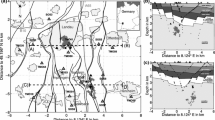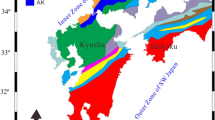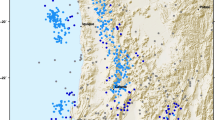Abstract
Seismic waveform clustering is a useful technique for lithologic identification and reservoir characterization. The current seismic waveform clustering algorithms are predominantly based on a fixed time window, which is applicable for layers of stable thickness. When a layer exhibits variable thickness in the seismic response, a fixed time window cannot provide comprehensive geologic information for the target interval. Therefore, we propose a novel approach for a waveform clustering workflow based on a variable time window to enable broader applications. The dynamic time warping (DTW) distance is first introduced to effectively measure the similarities between seismic waveforms with various lengths. We develop a DTW distance-based clustering algorithm to extract centroids, and we then determine the class of all seismic traces according to the DTW distances from centroids. To greatly reduce the computational complexity in seismic data application, we propose a superpixel-based seismic data thinning approach. We further propose an integrated workflow that can be applied to practical seismic data by incorporating the DTW distance-based clustering and seismic data thinning algorithms. We evaluated the performance by applying the proposed workflow to synthetic seismograms and seismic survey data. Compared with the the traditional waveform clustering method, the synthetic seismogram results demonstrate the enhanced capability of the proposed workflow to detect boundaries of different lithologies or lithologic associations with variable thickness. Results from a practical application show that the planar map of seismic waveform clustering obtained by the proposed workflow correlates well with the geological characteristics of wells in terms of reservoir thickness.
Similar content being viewed by others
References
Chopra, S., and Marfurt, K. J., 2014, Seismic facies analysis using generative topographic mapping, 84th Annual International Meeting, SEG, Expanded Abstracts, 1390–1394.
Coléou, T., Poupon, M., and Azbel, K., 2003, Unsupervised seismic facies classification: A review and comparison of techniques and implementation: The Leading Edge, 22, 942–953.
de Matos, M. C., Osorio, P. L., and Johann, P. R., 2006, Unsupervised seismic facies analysis using wavelet transform and self-organizing maps: Geophysics, 72(1), 9–21.
Han, J.W., Kamber, M., and Pei, J., 2012, Data mining: concepts and techniques (third edition): Elsevier Inc.
Hou, J., Xie, L., Yang, P., et al., 2017, Spoken term detection based on DTW, Journal of Tsinghua University(Science and Technology), vol. 57, pp. 18–23.
Itakura, F., 1975, Minimum prediction residual principle applied to speech recognition, IEEE Trans. Acoustics, Speech and Signal Processing, Vol. ASSP-23, pp. 57–72.
Kim, C., and Seo, K.D., 2005, Robust dtw-based recognition algorithm for hand-held consumer devices [speech recognition], IEEE Transactions on Consumer Electronics, 51(2), 699–709.
Köhler, A., Ohrnberger, M., and Scherbaum, F., 2010, Unsupervised pattern recognition in continuous seismic wavefield records using Self-Organizing Maps: Geophysical Journal International, 182, 1619–1630.
Kohonen, T., 1982, Self-organized formation of topologically correct feature maps: Biological Cybernetics, 43(1), 59–69.
Liu, J., Cheng, Q., Zheng, Z., et al., 2002, A dtw-based probability model for speaker feature analysis and data mining. Pattern Recognition Letters, 23(11), 1271–1276.
Liu, J., Dai, X., Gan, L., et al., 2018, Supervised seismic facies analysis based on image segmentation: Geophysics, 83(2), O25–O30.
Roy, A., Dowdell, B. L., and Marfurt, K. J., 2013, Characterizing a Mississippian tripolitic chert reservoir using 3D unsupervised and supervised multiattribute seismic facies analysis: An example from Osage County, Oklahoma: Interpretation, 1(2), SB109–SB124.
Ren, X., and Malik, J., 2003, Learning a classification model for segmentation, IEEE International Conference on Computer Vision, vol.1, 1:10–17.
Saggaf, M. M., Toksöz, M. N., and Marhoon, M. I., 2003, Seismic facies classification and identification by competitive neural networks: Geophysics, 68(6), 1984–1999.
Saraswat, P., and Sen, M. K., 2012, Artificial immune-based self-organizing maps for seismic-facies analysis: Geophysics, 77(4), O45–O53.
Sayago, J., Di, M., Lucia Mutti, M. A., et al., 2012, Characterization of a deeply buried paleokarst terrain in the Loppa High using core data and multiattribute seismic facies classification: AAPG Bulletin, 96, 1843–1866.
Sheikhan, M., Gharavian, D., and Ashoftedel, F., 2012, Using dtw neural-based mfcc warping to improve emotional speech recognition. Neural Computing & Applications, 21(7), 1765–1773.
West, B. P., May, S. R., Eastwood, J. E., et al., 2002, Interactive seismic facies classification using textural attributes and neural networks: The Leading Edge, 21, 1042–1049.
Zhang, Y., and Glass, J.R., 2009, Unsupervised Spoken Keyword Spotting via Segmental DTW on Gaussian Posteriorgrams, IEEE Workshop on Automatic Speech Recognition & Understanding.
Zhao, T., Li, F., and Marfurt, K. J., 2017, Constraining self-organizing map facies analysis with stratigraphy: An approach to increase the credibility in automatic seismic facies classification: Interpretation, 5, T163–T171.
Zhao, T., Zhang, J., Li, F., et al., 2016, Characterizing a turbidite system in Canterbury Basin, New Zealand, using seismic attributes and distance-preserving self organizing maps: Interpretation, 4, SB79–SB89.
Author information
Authors and Affiliations
Corresponding author
Additional information
This work was supported by the National Science and Technology Major Project (No. 2017ZX05001-003).
Hong Zhong received his M.S. (2010) in petroleum geology from Yangtze University. He has worked at the PetroChina Research Institute of Exploration and Development-Northwest since 2010. Zhong is currently pursuing his doctoral degree in information and communication at the University of Electronic Science and Technology of China. His main research interests include seismic interpretation, reservoir characterization, and machine learning for seismic exploration. Email: hongzhong_go@petrochina.com.cn
Rights and permissions
About this article
Cite this article
Hong, Z., Li, KH., Su, MJ. et al. A DTW distance-based seismic waveform clustering method for layers of varying thickness. Appl. Geophys. 17, 171–181 (2020). https://doi.org/10.1007/s11770-020-0819-5
Received:
Revised:
Published:
Issue Date:
DOI: https://doi.org/10.1007/s11770-020-0819-5




